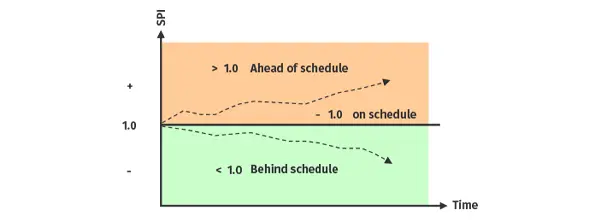
In project management, performance measurement is key to delivering projects on time and within budget. Two critical indicators for tracking efficiency and progress are the Cost Performance Index (CPI) and the Schedule Performance Index (SPI).
Together, these metrics form the foundation of Earned Value Management (EVM), a methodology endorsed by the AACE for evaluating cost and schedule efficiency. When properly monitored, CPI and SPI provide valuable insights that help project teams take corrective action early and ensure successful project delivery.
Understanding CPI and SPI
Before diving into calculations, it’s important to understand what the Schedule Performance Index (SPI) and Cost Performance Index (CPI) actually represent.
Both metrics compare the earned value (EV) of work completed to planned or actual values. Project managers can use this to determine whether their project is progressing according to plan, both in terms of time and cost.
To put it simply:
- SPI measures how efficiently the project is utilizing time.
- CPI measures how efficiently the project is utilizing budget.
By tracking these two indices, organizations can obtain a quantitative understanding of project performance, which goes beyond simple schedule updates or cost reports.
What is the Schedule Performance Index (SPI)?
The Schedule Performance Index (SPI) measures how efficiently the project team is progressing compared to the planned schedule. It indicates whether the project is ahead or behind in terms of planned work.
Here is the formula to calculate SPI:
SPI = EV / PV
Where:
- EV (Earned Value) = The value of work actually performed.
- PV (Planned Value) = The value of work planned to be performed.
Interpretation:
- SPI = 1.0. The project is exactly on schedule.
- SPI > 1.0. The project is ahead of schedule.
- SPI < 1.0. The project is behind schedule.

For instance, an SPI of 0.85 indicates that the project is progressing at 85% of the planned rate. This is a clear signal to investigate what caused the schedule bottleneck.
From practical experience, a consistently low SPI often indicates underestimated durations or resource constraints that were missed in the baseline schedule. Project controls software like Cleopatra Enterprise can detect these issues early by combining live progress updates with the baseline plan.
What is the Cost Performance Index (CPI)?
The Cost Performance Index (CPI) shows how cost-effective a project is. It compares the value of completed work to the actual costs incurred in doing that work.
Here is the formula to calculate CPI:
CPI = EV / AC
Where:
- EV (Earned Value) = Value of work performed.
- AC (Actual Cost) = Actual cost incurred for that work.
Interpretation:
- CPI = 1.0. The project is exactly on budget.
- CPI > 1.0. The project is under budget (cost-efficient).
- CPI < 1.0. The project is over budget (cost-inefficient).

For example, a CPI of 0.92 means that for every $1 spent, only $0.92 of value has been earned. This suggests that spending efficiency needs to improve.
In real-world projects, CPI trends often uncover deeper cost problems such as inaccurate estimates, poor procurement control, or inefficient resource use. Monitoring CPI through integrated cost management systems like Cleopatra Enterprise allows teams to respond quickly with data-driven actions.
What is the Difference Between CPI and SPI?
While both are essential Earned Value Management (EVM) metrics, they focus on different aspects of project performance. The Cost Performance Index (CPI) measures cost efficiency, while the Schedule Performance Index (SPI) measures schedule efficiency. To better understand the differences and applications of SPI and CPI, refer to the comparison table below:
| Criteria | Cost Performance Index (CPI) | Schedule Performance Index (SPI) |
|---|---|---|
| Formula | CPI= Earned Value (EV) / Actual Cost (AC) | SPI= Earned Value (EV) / Planned Value (PV) |
| Purpose | Measures the cost efficiency of project work | Measures the schedule efficiency of project work |
| Interpretation | CPI>1: Under budget CPI=1: Over budget CPI<1: Over budget |
SPI>1: Ahead of schedule SPI=1: On schedule SPI<1: Behind schedule |
| Usage and application | Used for cost control, forecasting, and identifying areas of overspending or savings | Used for schedule tracking, progress forecasting, and identifying potential delays |
| Relation to Earned Value (EV) | Compares EV to the actual cost incurred to evaluate financial efficiency | Compares EV to the planned value to evaluate schedule efficiency |
Table 1. Cost Performance Index vs Schedule Performance Index
In essence, the Schedule Performance Index and Cost Performance Index complement each other in project management. Together, they provide a holistic view of project performance. CPI measures cost efficiency, while SPI measures schedule efficiency. Both are vital for making informed and data-driven decisions that balance cost, schedule, and overall project success.
Interpreting CPI and SPI in Project Management
Understanding CPI and SPI values is crucial for accurate project performance analysis. These indices act as early warning indicators that help project managers identify potential risks before they escalate.
When interpreting SPI and CPI values, it’s vital to assess trends over time instead of focusing on isolated data points. A one-time dip may not be alarming, but a persistent downward trend could indicate systemic project issues.
For example:
- A declining CPI might suggest increasing costs due to poor scope control or unforeseen risks.
- A declining SPI could mean the project is lagging because of resource shortages or delays in the schedule.
An experienced project manager knows that no single metric provides the complete picture. The Cost Performance Index and Schedule Performance Index should always be analyzed in conjunction with qualitative factors such as incomplete planning, over-optimistic scheduling, bad risk analysis, change orders, and team productivity.
Understanding SPI and CPI Thresholds
Knowing the thresholds for CPI and SPI values helps teams set realistic performance benchmarks.
- If SPI and CPI are greater than 1: The project is performing efficiently. Work is progressing faster and/or at a lower cost than planned.
- If SPI and CPI are less than 1: The project is underperforming; it is falling behind schedule or going over budget. Immediate corrective action may be necessary.
- If CPI is higher than 1 an SPI is lower than 1: The project is under budget but behind schedule. This means that while cost efficiency is good, the pace of progress is slower than expected. In such cases, teams may be saving costs by using fewer resources or working cautiously. However, this can delay delivery. Thus, you should assess whether the slower progress will affect critical milestones or contractual deadlines.
- If CPI is lower than 1 and SPI is higher than 1: The project is over budget but ahead of schedule. In other words, work is progressing faster than planned, but the project has cost overruns. These could be due to overtime, resource inefficiency, or expedited procurement. While being ahead of schedule may seem positive, cost overruns can erode profitability or strain the project’s financial health. A balance between speed and cost control is needed.
Many organizations use thresholds like 0.9 or 1.1 as early warning limits. A CPI or SPI outside this range typically triggers management attention and leads to root cause analysis.
In practice, thresholds should be tailored to the type and complexity of the project. For example, in large capital projects or turnarounds, small deviations can cause significant downstream impacts. This highlights the need for real-time monitoring through integrated systems like Cleopatra Enterprise’s project controls platform.
Using SPI and CPI to Improve Project Performance

Monitoring Cost Performance Index and Schedule Performance Index is only the first step. The real value lies in using these insights to drive better decisions and improve project outcomes.
Here are several strategies experienced project managers use:
- Implement continuous tracking: Automate data collection for EV, AC, and PV with digital tools or EVM software, as manual reporting delays often hide early warning signals.
- Identify root causes quickly: If CPI drops below 1, analyze cost drivers such as labor, materials, or scope changes. If SPI falls, review resource allocation or task dependencies.
- Forecast future performance: Use current CPI and SPI values to calculate Estimate at Completion (EAC) and predict final cost or schedule performance.
- Integrate cost and schedule control: Avoid managing budgets and timelines in silos. Instead, platforms like Cleopatra Enterprise integrate cost, schedule, scope, and risk data, providing teams with a complete view.
- Encourage transparent communication: Share CPI and SPI trends with stakeholders. Transparency fosters proactive problem-solving instead of reactive firefighting.
- Use historical data for benchmarking: Leverage past CPI and SPI performance to refine future project estimates and improve forecasting accuracy.
Expert tip: In turnaround and capital-intensive industries, even a small improvement in CPI or SPI can lead to millions in savings. Regular variance reviews and automated dashboards make this achievable. Furthermore, if you take corrective actions, whether you add more scope or increase the budget, please note that this will most likely influence other factors as well. This interdependence is well explained by the Triple Constraint Theory, which emphasizes the balance between scope, time, and cost.
By combining Earned Value Management with advanced analytics from Cleopatra Enterprise, organizations can shift from reactive reporting to proactive performance control. CPI and SPI are strategic levers for managing project success, improving predictability, and maximizing value throughout the project lifecycle.
What is Project Cost Management? Project cost management focuses on finding the right project and carrying it out…
Operational efficiency in project management is about achieving more with less: delivering projects on time and within budget…
Related resources
Project Cost Tracking: A Practical Guide
Effective project cost tracking is essential to staying on budget and making informed decisions. This guide explains how to track costs step-by-step, avoid overruns, and use tools like CPI and EAC to forecast and control spending throughout the project lifecycle.
Read blog article
An Earned Value Management (EVM) Guide
Scope creep, budget constraints, and aligning actual work with planned tasks are just a few of the challenges faced by project managers. Ever wondered how amid these obstacles project managers keep track of progress effectively? Earned Value Management (EVM) is their not-so-secret weapon. Understanding EVM's significance is crucial; it not…
Scope creep, budget constraints, and aligning actual work with planned tasks are just a few of the challenges…
Read blog article